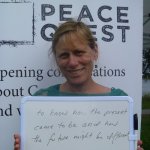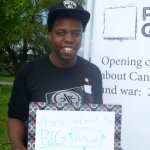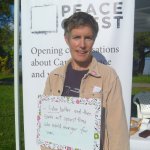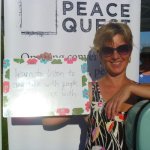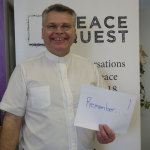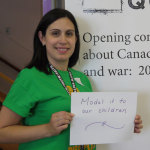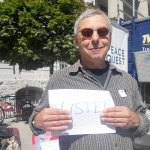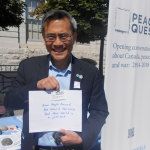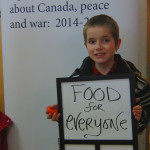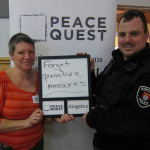Robert Kiley on the White Poppy
Kingston is a reasonably small city of 130,000 with both a Canadian Armed Forces base and the Royal Military College. After election to city council in 2018, Robert Kiley began receiving negative feedback stemming from his choice to wear a white poppy on Remembrance Day. In this Kingstonist article, Kiley reflects on his family history, the horrors of war, and the opportunities that await societies that prioritize culture and health over the taking up of arms. Thank you for sharing it with us Robb!

Why do you wear a poppy in November? Remembrance? Respect? Honouring a loved one? Tradition? These are all valid reasons. They are beautiful, higher truths that touch all of our lives.
Yes, when we drop our coins in the Legion’s paper box this time of year and pick up a poppy, we are thrust into a grand narrative of love and loss. This story is indeed built on remembrance. But maybe not in the way we might imagine or think of it immediately, as the bugle plays on and we say together “Lest We Forget.”
Not forgetting is another way of saying remembering. To remember, though, is different than to recollect, retell, recall, or relive. Remember comes from the latin memor, meaning ‘mindful.’ To me, to be mindful is to consider, contemplate, think on, and commit to a new way of being. This is an intensely personal act with great collective ramifications because mindfulness can be transformative. And this story of remembrance is intensely personal and transformative, if we let it be.
Let’s start the story in Guelph, Ont. The year, 1872. My great-great-grandma’s cousin was born there and then. His name was John, the descendant of Scottish immigrants. I know little of his life is Southwestern Ontario other than family lore (my confirmation of our shared lineage comes only by way of my mother and grandfather’s oral histories at this point. I hope to further explore our connection in time to come). What I do know is that 26 years later, near the turn of the 20th century, he graduated from the University of Toronto as a surgeon. Only two years after that, he served in the second Boer War.
It wasn’t his time in South Africa that he is best known for, however, nor his successful medical career. John’s fame was found, as you may have guessed (in light of the article’s theme or other biographical details) in his correspondence from Belgium, his poetry.
John McCrae’s potent portrayal of longing, lament, and leadership haunt us on 11/11. I hope it convicts us, too, because in Flanders Fields, the poppies did grow “row on row.” Those poppies, unlike the one on my lapel, were red, like the blood spilled by those on both sides of that historical atrocity.
Given the cogent context in which Lt.-Col. McCrae penned his piece, red poppies serve as a cutting reminder of those who bravely gave their lives in service to their respective countries, particularly in WWI, where the wispy flower punctured the landscape of the Western Front. For this reason, it is right and good that the Royal Canadian Legion sells them every year to raise funds for veterans’ programs.
I feel very strongly about this: We owe both deep gratitude and concrete action to support those who have given so much for us. Too many have offered “no greater love,” only to be forgotten in return. As a city councillor, for instance, I believe that Legions should not pay property tax. There’s nothing wrong with taxes in and of themselves, but saving these important institutions money is the least a municipality can do to show our appreciation for men and women in uniform, past and present. The federal government must also do more to fund mental health programs, affordable housing, and other veteran supports. If we have people in the line of duty, they should have all they need to live well during and after their service.
Yet, despite my convictions about caring for the troops, the poppy I wear is white. A white poppy, also known as a peace poppy, is a form of remembrance too. It has nothing to do with disrespect — despite that being a quick association some make when they see it. I pinned mine on my suit jacket on November 1, 2019, nearly 100 years after they were first introduced.
I was shocked at the personal and professional attention that this small act received in a few short days, online and in person. The comments were largely negative. But I think they should be positive. Why? Because white poppies encourage mindfulness, which is the spirit, the essence, of the remembrance season — they ask us to think long and hard about the value of life and the horror of war. It doesn’t stop there though. White poppies are a symbol that beg us to do all we can to make a more gracious and generous world. Of course, you can do this while wearing any colour poppy you want, I don’t want to suggest otherwise.
Some people wear only red or only white poppies. Some have white and red poppies on their lapels at the same time. Some pin purple poppies to remember animals that were killed in the Great War. I’ve heard novel designs suggested like red in the middle with white on the edges or the words “no more war” in the centre of red poppies. Some chose none of the above.
Either way, as we are mindful of war — at Remembrance Day ceremonies, in conversation with veterans, during our own quiet times, or elsewhere — it is vital to know that white is not in opposition to any of these crucial collective moments in our civic life, communal memory, or individual contemplation. Instead, white is a sign of pacifism. Not a cowardly dereliction of duty or helpless naivete. Rather a gutsy, full-on, fierce and loving push for peace, which looks at things as they are for an honest assessment of how we can foster strong, progressive conditions to help create life at its full. Pacifism, as I understand it, is about doing the things which empower, encourage, and enliven our communities and the world. Most especially, pacifism and the white poppy are not a critique of the heroism of those who died in service to their country.
Yes, to be against war is not to be against soldiers. It is only to say that there has to be a better way than killing one another to resolve conflict, in every setting, not least nationally. Laying down our lives for our friends, this is the way to a fruitful existence for sure. Yet brutally slaughtering one another with industrial equipment, in battles with “our foes,” is likely not the ultimate expression of the noble and true principle of self-sacrifice.
That is where, it seems, my story parts from my long distant cousin’s. With great compassion and profound respect, I wish not to “break faith with those who die.” I just can’t “take up [their] quarrel.” At least not if that means waging war. Seeing other countries or people as opponents worthy of death, even when they do horrendous things, is problematic. It discounts the intrinsic worth we all carry as human beings.
Even leaving our so-called enemies out of the conversation, I think that we best serve those who serve us (our “allies”) by not putting them in such awful situations once again. We should offer a more prosperous and peaceful future for everyone instead of a dangerous and deadly one marked by militarized aggression.
WWI was known as the “war to end all wars.” It is heart-breaking and mind-numbing that it was not. If only! Since those horrific moments of mustard gas and the introduction of machine guns, we have seen atomic bombs, proxy fighting, regional strife, genocides, mass terror, and the senseless killings of millions of people from state-on-state violence that can only be called cataclysmic and catastrophic. “Never again,” a saying so powerful, sadly begins to lose its power as it can be applied to so many circumstances.
Therefore I choose to remember with white. White calls us to the transformation that can come from remembering. Transformation from a society that accepts killing, even under noble guises, to one that does not kill in any way shape or form. ‘Never again’ can then, it is hoped, truly mean ‘never again.’
To be incredibly clear, I am not suggesting that our current Remembrance Day ceremonies, or any person or organization associated with them, are promoting war. Most events on November 11 are simply sombre moments with remnants of militarism. I am only saying we must go further in promoting peace explicitly, clearly, unequivocally in this time of all times. Let’s tell another story on Remembrance Day, one that takes us beyond dystopian destruction to fundamental flourishing.
What does that look like? The possibilities seem endless. Schools and theatres and hospitals and parks and art galleries and sports stadiums and rehabilitation centres and so many other meaningful pieces of public infrastructure could be built, maintained, and expand upon with the money we spend on combat. Of course, there are thousands of details to sort through as we make the changes needed to get there, a revolution in international relations and individual relationships with the wellbeing of all people — including the troops — top of mind. But mountains are climbable, systems changeable, and, as non-violent icons from Jesus to Ghandi and Dorthy Day to Martin Luther King Jr have proven: otro mundo es posible.
So I remember. I am mindful. I consider those who gave what they did, in conflicts a century ago and today. They were and are real people in real situations. Whether passed or still alive, I contemplate the absolute resolve of those who have served in the reserves (like my mom), the military (my church friends), the navy (high school friend’s parents), and the air force (my maternal-great grandpa). They have, with their compatriots, had tremendous discipline, determination, and valour. They face unconscionable realities in stride.
Ultimately, I think on those characteristics and the amazing things we could accomplish if we channelled their courage, hard work, and conviction — the willingness to lay down their lives — for peace instead of war. I commit to the faith that that reality will, one day in some glorious way, come to be. That’s a transformative story I want to be a part of.
And that’s why I wear a white poppy.

Robert Kiley is Kingston City Councillor for Trillium District. He writes a monthly “behind the scenes” piece for the Kingstonist. He tweets at @robert_kiley.
